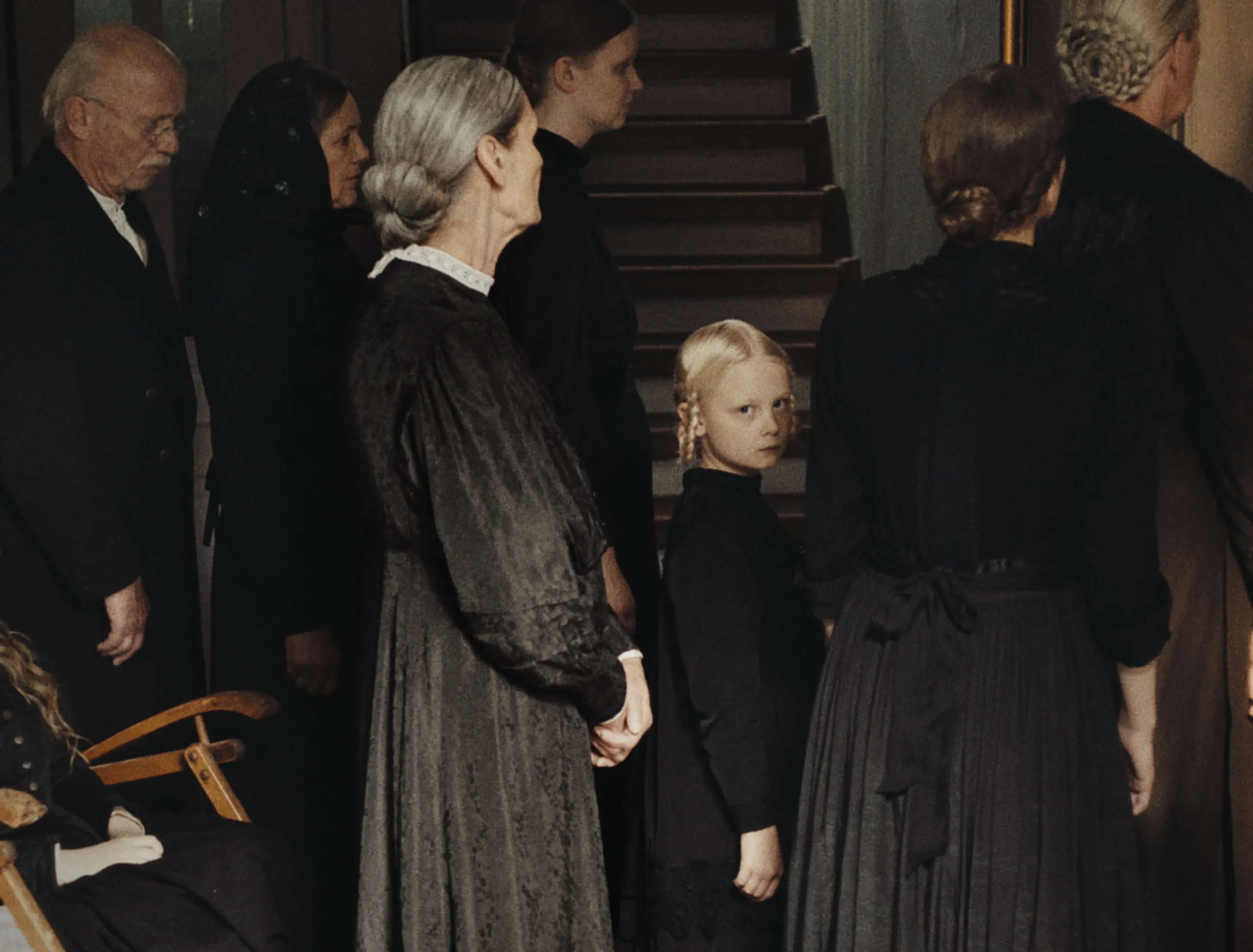SOUND OF FALLING premiered at the 45th Hawai‘i International Film Festival presented by Halekulani
“Deadline as a word used to fascinate me,” writes Yiyun Li in her novel Where Reasons End, “a word that connects time and space and death with such absoluteness.” Deadlines have fatigued our lives, becoming a banality more disrespected than not these days—yet Li begs to differ on the word’s intended value. Her preoccupation took me on an etymological investigation: the term was originally coined by Henry Wirz, a commander of a Confederate prison in Andersonville, Georgia, for the prison’s enclosures of wooden boards nailed down, beyond which prisoners would be shot to death. Circa 1920, journalists gave the word a stricter temporal dimension, reinterpreting the deadline as the last minute to send copy to the printer. It’s the original idea of a deadline, the existential threshold between life and death, that propels Mascha Schilinski’s sophomore feature, SOUND OF FALLING (2025), a haunting sketch of four generations of women living on a northern German farmstead from the early twentieth century to the present day. What connects these women is the impulse to draw their own deadlines and architect the circumstances of their death, even as the cruelties of global war, state partitioning, and rural patriarchy simultaneously conspire to fix other deadlines for them.
Of all the historical material Schilinski and co-writer Louise Peter combed through while developing the film, a sentence from a dairy maid remained with them: “In truth, I have lived completely in vain.” This unbearable confession hangs over the heads of the film’s protagonists. The young Alma (Hanna Heckt) at the turn of the twentieth century expects her death by the end of the summer—for all the violence she witnesses on the farmstead, she is preoccupied by a mantlepiece photograph of an apparition-like mother whose face is blurred in the exposure and a girl in rigor mortis, whom Alma’s sisters cryptically claim is her. The keen-eyed Erika (Lea Drinda) fights through malaise in the aftermath of World War II, and later is electrocuted by eels in the Elbe River when she tries to emigrate to West Germany. In Soviet-era East Germany, Angelika (Lena Urzendowsky) buckles under the weight of a brute rural patriarchy, largely due to her uncle Uwe’s (Konstantin Lindhorst) grooming. Closest to the present day, Lenka (Laeni Geiseler) yearns for a life saturated with melodrama, harboring sapphic jealousy of her neighbor Kaya (Ninel Geiger), whose mother died of lung cancer. These women are dying as much as they are living, embodying Schilinski’s vision of how closely the two states press against each other.
Cinematographer Fabian Gamper recurs to deadlines as an image of self-extinction, where such a fantasy becomes a realm in which protagonists articulate their historical despair. Angelika waves red flags to signal her father’s combine toward her direction, then dives into the field of wheat before his blades. The scene is all within Angelika’s head, a suicidal ideation fiercely intrusive and vivid—yet it is a sincere articulation of how regimented labor and sexual exploitation have moved her toward her deadline. The scene rhymes with another in which Lenka, abandoned after swimming with her family, imagines mummifying herself in a towel, then tumbling down the banks of the river Elbe to drown. And again, when Erika pretends she has an amputated leg like her uncle while she is bored, and again, when Alma’s sister, Lia (Greta Kramer), escapes being sold as chattel by jumping off a hay wagon to be crushed under its wheels. Deadlines connect these women, who, in a surreal, unspoken recognition, defy fate and pursue a life otherwise because they have heard the static of a life lived in vain.
A different dance along deadlines occurs in the film’s diaristic narration, as Schilinski’s protagonists confront how men impose upon their bodies, marking boundaries that limit women’s ability to see themselves beyond such imposition. The film presents a litany of violence against women, among the most stark being the sterilization of the maid Trudi (Luzia Oppermann) to “make her safe,” a literal deadline around her body and autonomy. Such a patriarchal order sets deadlines at worst and obscures self-perception at best: the precocious Alma captures this cruelty when she observes, “You always see things from the outside, but never yourself.” It’s as if Alma knows to speak of the perspectival violence right when Schilinski’s camera gazes at her—when we can see her in her entirety—implicating us in the power dynamic Susan Sontag troubles in ON PHOTOGRAPHY, that “to photograph people is to violate them, by seeing them as they never see themselves, by having knowledge of them that they can never have.” Despite masculine connotations to the camera’s gaze, Schilinski cites the late American photographer Francesca Woodman as her inspiration, whose translucent and enigmatic subjects become a refusal of the clarity we are granted of our protagonists. Woodman’s traces pervade the film, evident in the mysterious characters of the macabre tableau of Alma’s era and in the Polaroid family photo, where Angelika is last seen in a blur, in defiance of where men—and even the camera itself—position women.
It’s a shape of contradiction, how deadlines also become an axis for survival in SOUND OF FALLING. In her artist book, SOME DISORDERED INTERIOR GEOMETRIES, Woodman questions “where I fit in this odd geometry of time,” positing that the existential problem of belonging is equally a mathematical one. I’d say that Schilinski would accept Woodman’s geometric terms but would be more concerned with how to find empowerment in such a configuration. SOUND OF FALLING challenges us to consider how scenes of dignity can still emerge from powerless protagonists, recognizing a fragile though meaningful level of agency, even as the film depicts the forces that lead protagonists to these decisions. What is the possibility for deadlines to become something more than markers of repression, but frameworks through which women navigate survival and selfhood? It’s an evergreen question that haunts literature, tracing a lineage from Dido atop her funeral pyre and Ophelia drifting in the river, and Schilinski continues the tradition in film, staunchly refusing didacticism. Like Woodman’s translucent figures, the question is evasive and enigmatic, a geometry with just the right amount of absence to avoid the imposition of others.
The HIFF ONLINE CREATIVES & CRITICS IMMERSIVE (HOCCI) program supports sustainable film criticism in Hawai’i through mentorship and paid career opportunities for Hawai’i-based AANHPI critics. The mission of HOCCI is to broaden diversity in film criticism across the Pacific and use influencer branding strategies to spark career opportunities. The 2025 HOCCI is supported by Critical Minded, a grant-making and learning initiative that supports cultural critics of color in the United States.

Connor Arakaki is a Native Hawaiian journalist and screenwriter studying at Yale University, where she previously served as the editor in chief of the Yale Herald. You can find her words in The Nation, DIAGRAM, The New Journal, Hawai‘i News Now, and elsewhere. She is committed to accountability-driven writing that platforms Indigenous voices and those often underrepresented in traditional media and criticism. She is currently working on a screenplay titled DISORIENTATION, which traces the lives of two Native Hawaiian students as they unravel the founding history of their university during the first week of classes.



